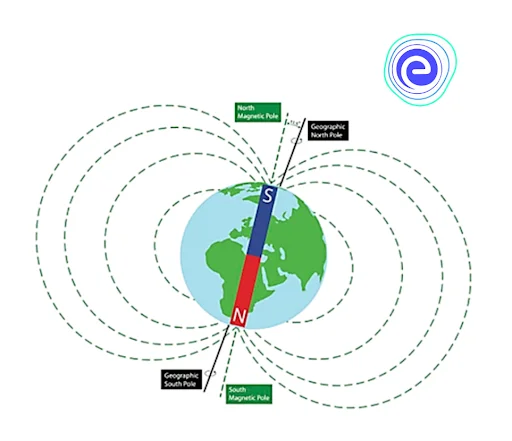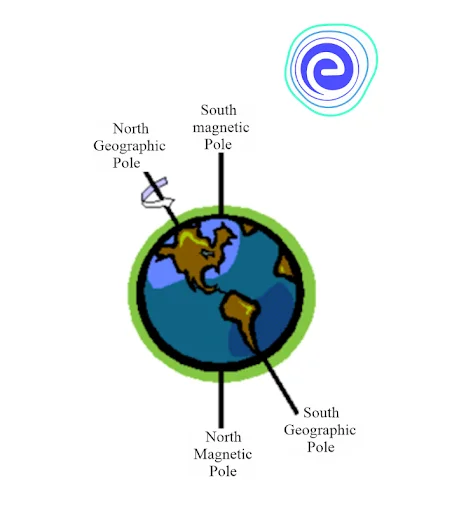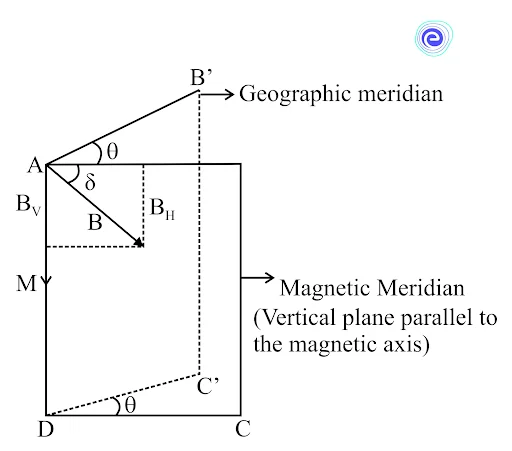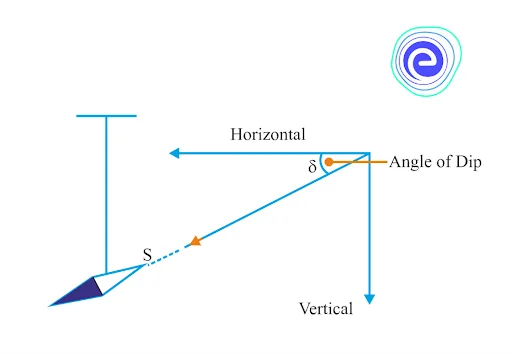- Written By
nikhil
- Last Modified 22-01-2025
Earth’s Magnetism: Definition, Cause, Theory
Earth’s Magnetism: Did you ever lose the sense of direction on any trekking? In such a situation, a magnetic compass will come to your rescue; we know that the magnetic needle of the compass always points north. If you hang a bar magnet from the ceiling, it will also point towards north.
This implies that something invisible is influencing all the magnets near Earth’s vicinity. In fact, it is the Earth that generates a magnetic field all around us. Apart from helping in navigation, the presence of a magnetic field acts as a protective shield around the Earth, repelling and trapping charged particles from the Sun.
Earth’s Magnetism: Types of Magnets
The magnet is primarily classified into three types:
A permanent magnet is a magnet made of a material that is permanently magnetised and generates its own consistent magnetic field. Ferromagnetic materials are those that can be magnetised. Iron, nickel, and cobalt are examples of such materials.
Magnetic Compass Bar Magnet Suspended by Thread
Temporary Magnet – A magnet that is only magnetised for a short time. The materials used to make these magnets are typically soft and have low magnetic properties. When a powerful or permanent magnet attracts them, they become magnetised for a brief period of time.
Electromagnet – A magnet that generates a magnetic field due to the current flowing through it. The wire wound into a coil is the most common type of electromagnet; when current flows through the wire, a magnetic field is created inside the coil.
It vanishes as soon as the current is interrupted. Electromagnets are primarily found in devices such as motors, generators, and hard disc drives.
Earth’s Magnetic Field
The Earth’s magnetic field extends millions of kilometres into deep space and resembles a bar magnet. This magnetic field extends over long distances and is very wide, but it has a low strength; it varies between \(25000\,{\rm{nT}}\) to \(65000\,{\rm{nT}}\), having an average value of approximately \(40000\,{\rm{nT}}\), compared to an ordinary magnet’s \(10000000\,{\rm{nT}}\).
The Earth’s magnetic field is vital to us because it serves as a protective layer for the planet and repels and traps charged particles from the Sun.
The magnetic South pole of the Earth is located at the geographical North pole, and the magnetic North pole is located at the geographical South pole. This is why the compass’s magnet points north, because the Earth magnet’s South pole attracts the compass’s North pole.
The magnetic North pole is located to the south in Northern Canada; the geographic South pole is at the centre of the Antarctic continent, but the magnetic pole is hundreds of miles away, near the coast. In regions near the magnetic poles, compasses are virtually useless.
The magnetic field deflects the solar wind, which is composed of ionised charged particles emitted by the sun. These winds have the potential to enter our atmosphere and gradually degrade it. Magnetic fields keep them from entering the Earth’s atmosphere, allowing life to exist. Mars lacks a magnetic field, making life impossible there.
Theory of Earth’s Magnetism
There is one theory that explains how the earth’s magnetism is caused:
1. Dynamo Effect: The Earth gets its own magnetic field lines because of the presence of the metallic fluids that are present at the outer core as well as in the inner core. The outer core consists of molten iron, while the inner core has solidified elements. The inside of the core is extremely hot and contains a large number of molten minerals and metals.
Molten iron and nickel are examples of such minerals. The Earth’s core is extremely hot, and it constantly boils these minerals. This constant heating causes convection in them, which results in a process known as convection currents. These currents transport charged particles and generate the magnetic field.
2. Ionization of the Outer Layer – As we all know, the Earth rotates both on its own axis and around the Sun. As the Earth’s outer layer is ionised, this rotation generates an electric current. Because these ions move, magnetism is produced. But this magnetic field is very weak, so the Dynamo effect is a more acceptable
Changes in Earth’s Magnetic Field
Secular Variation: Every \(960\) years, the magnetic axis undergoes a change as a result of its spin around its own axis.
Daily and Annual Variations: The Sun’s ultraviolet rays ionise the Earth’s atmosphere on a daily basis. As a result, a current is produced, and this current generates magnetic fields. This varies on a daily and annual basis.
Eleven-year Sunspot Cycle: On the Sun, there is a region with a strong magnetic field. Earth faces that region every eleven years due to variations in the Earth’s magnetic field.
Lunar Variations: The Moon, like the Sun, has a significant impact on Earth’s magnetic activity. During a lunar eclipse, the earth’s ionised layer undergoes tidal motions, resulting in variations in Earth’s magnetic field.
Components of Earth’s Magnetic Field
The Earth’s magnetic field has three components that are responsible for the magnitude as well as the direction, they are called:
- Magnetic declination
- Magnetic inclination or the angle of dip
- Horizontal component of the earth’s magnetic field
Magnetic Declination
When a magnetic needle is-floating in the air, it always points north-south. Magnetic Meridian is the direction in which a magnetic needle pointsly in a specific direction of all other attracting forces. Magnetic declination is the angle formed by the magnetic meridian and the geographic meridian. The plane passing through the earth’s north and south poles is defined as a geographic meridian.
Magnetic Inclination or Angle of Dip
Magnetic inclination is also referred to as the angle of dip. It is the angle formed between the magnetic field line and the Earth’s horizontal plane. The magnetic equator has a dip angle of \({0^{\rm{o}}}\), while the magnetic poles have a dip angle of \({90^{\rm{o}}}\).
As shown in the diagram above, suspend a magnetic needlely so that it can rotate about a horizontal axis: The Angle of Dip or Magnetic Inclination is the angle formed by the north pole of the needle with the horizontal axis.
Component of Earth’s Magnetic Field
The magnetic intensity of the earth’s magnetic field forms an angle with the horizontal axis known as the Angle of Dip \(\left( \delta \right)\). The intensity of the Earth’s magnetic field can be divided into two parts:
- Vertical Component \(\left( {\rm{H}} \right)\)
- Horizontal Component \(\left( {\rm{V}} \right)\)
\(\tan \delta = \frac{{{B_v}}}{{{B_H}}}\)
\(\sin \delta = \frac{{{B_v}}}{B}\)
\(\cos \delta = \frac{{{B_H}}}{B}\)
\({\sin ^2}\delta + {\cos ^2}\delta = \frac{{B_H^2}}{{{B^2}}} + \frac{{B_v^2}}{{{B^2}}}\)
\(1 = \frac{{B_H^2}}{{{B^2}}} + \frac{{B_v^2}}{{{B^2}}}\)
\(B = \sqrt {B_H^2 + B_V^2} \)
Summary of Earth’s Magnetism
The core of Earth contains conductive material, such as iron, which can generate magnetic fields when exposed to an electric current. This mechanism is thought to be responsible for the Earth’s magnetic field. Convection currents caused by heat escaping from the core are thought to be responsible for the electric currents.
Earth behaves like a giant magnet, having magnetic poles near geographical poles. However, the magnetic North pole lies close to the geographical South, and the Magnetic South pole lies close to the geographical North pole.
The intensity and the direction of the Earth’s magnetic field vary at different locations. The angle of dip or angle of inclination at any location can help us find the magnetic field strength at that place.
Earth’s Magnetism Solved Examples
Q.1. Find the vertical and horizontal components of the Earth’s magnetic field at the equator, given that the horizontal component of the Earth’s magnetic field is \(B\) and here the angle of dip is found to be \({60^{\rm{o}}}\).
Ans:
We know that the vertical component of the Earth’s magnetic field is given by
\({B_V} = B\,\sin \,\delta \)
\({B_V} = B\,\sin \,{60^{\rm{o}}}\)
The vertical component of the earth’s magnetic field,
\({B_V} = B \times \sqrt {\frac{3}{2}} \)
Similarly, we also know that the horizontal component of the earth’s magnetic field is given by
\({B_H} = B\,\cos \,\delta \)
\({B_H} = B\,\cos \,{60^{\rm{o}}}\)
\({B_H} = \frac{B}{2}\)
Q.2. Find the angle of dip for a place where horizontal and vertical components of the magnetic field of Earth are exactly the same.
Ans:
We know that the angle of dip is, \(\delta = {\tan ^{ – 1}}\left( {\frac{{{B_V}}}{{{B_H}}}} \right)\)
Where,
\({{B_V}}\) is the vertical component of the magnetic field of the Earth
\({{B_H}}\) is the horizontal component of the magnetic field of the Earth
Given that:
\({B_V} = {B_H}\)
\(\delta = {\tan ^{ – 1}}\left( 1 \right) = {45^{\rm{o}}} = \) angle of dip
Frequently Asked Questions (FAQs) on Earth’s Magnetism
Q1. How does magnetic compass work? Ans: Opposites attract when it comes to magnets, hence the magnetic needle of the compass aligns itself along the Earth’s magnetic field. A magnetic compass points to the Earth’s magnetic poles, which are distinct from the Earth’s geographic poles. Furthermore, the magnetic pole near the geographic north pole of the Earth is actually the south magnetic pole.
Q.2. What causes the magnetism of the Earth? Ans: Earth’s magnetism is caused by circulating ions that are highly conducting in the earth’s core, resulting in the formation of current loops. The magnetic field is formed as a result of these current loops.
Q.3. At a place on the Earth where a magnetic needle is to rotate in a vertical plane, what would be the horizontal component of the Earth’s magnetic field and angle of dip? Ans: Such phenomenon is observed near the poles. As the magnetic needle is kept to rotate in a vertical plane horizontal component of the Earth’s magnetic field is zero here. The angle of dip of this place would be 90 degrees.
Q.4. Does the Earth’s magnetic field not constant everywhere?
Ans: The magnetic field varies depending on where you are. Its value varies between \(25000{\rm{ nT}}\) to \(65000{\rm{ nT}}\). Magnetic field is affected by both location and time. Satellites and approximately 200 operational magnetic observatories around the world, as well as several more temporary sites, are used to measure the distribution of the magnetic field.
Q.5. What has happened to the Earth’s magnetic field over its history?
Ans: The magnetic field of the Earth is slowly changing and appears to have changed throughout its existence. When tectonic plates form along oceanic ridges, the magnetic field that exists is imprinted on the rock as it cools below 700 degrees Celsius.
Practice 10th CBSE Exam Questions
We hope this detailed article on Earth’s Magnetism helps you with your exam preparation. If you have further doubts do let us know about the same in the comments section below and we will get back to you at the earliest.
Stay tuned to embibe for the latest update on CBSE exams.














































